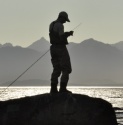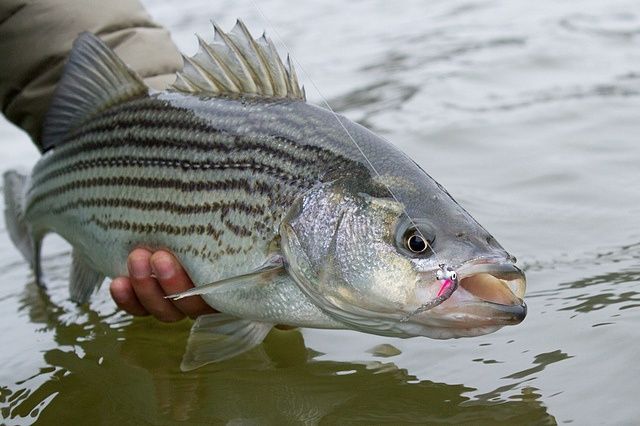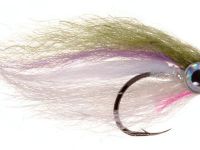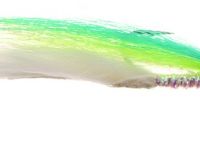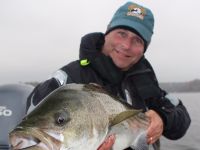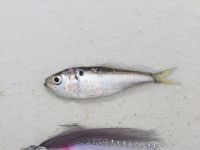Fd: How did you first get into fly fishing and tying?
H: I started fly fishing when I moved from Brooklyn, NY up to Stamford, CT back in the late 80’s. It was the spring of 90’ when I saw 3 young guys fishing a salt water beach for stripers next to me and having a ball catching 2-5lb bass on flies while I was fishing my lite tackle spinning gear. It was that moment when I had an epiphany.
Tying came soon after as I realized I needed some flies that mimicked the lures that I had been successfully using for the past 15 yrs of striper fishing the salt. By the spring of 91’ I was completely immersed into the sport of fly fishing and tying. I sold most of my conventional gear and my antique fishing lure collection to buy everything I needed to get going in the whippy sticking world.
Fd: What kind of spots were you fishing those days?
H: I grew up in the area known as Gravesend Bay which is located near Coney Island and is considered the entrance to NY Harbor. It was a salt water haven for striped bass, bluefish, weakfish, fluke and false albacore.
Fd: Do you enjoy tying other kinds of flies and fishing for trout or other species?
H: I LOVE fishing for trout! However I now live and guide in Atlanta, GA, and spend much of my time guiding folks to sodium free stripers as well as Kentucky spotted bass, largemouth bass and hybrids on either Lake Sidney Lanier or Lake Allatoona. I also guide the Chattahoochee River for carp which is one of my favorite species to fish for. As for trout, I only get to fish a few days a year for them as I am just too busy guiding for the other species.
Fd: What tips can you give to the tiers that want to tie flies like you?
H: The most important tip I can give to tiers who like to twist up streamer patterns is that less is more. Most of my fishing is done in fairly clear water so bulky patterns that push water is not as important as silhouette and breathability. Try to match the hatch as best as you can. Tying sparse flies is preferred to big -hard to throw- bulky patterns.
Fd: How important do you consider the eyes to be in streamers for saltwater species?
H: I think any type of fishing using artificial baits (flies or lures) needs to incorporate an element of confidence. In my opinion including an eye on your streamers is extremely important. Will they eat a fly tied as good without eyes? I am not sure but I know I have more confidence in my patterns that incorporate eyes in them than those that do not.
Fd: Do you believe color combinations are a huge game-changer?
H: I most certainly do believe in color combinations as being a game changer. I believe chartreuse is a “clear water” color. While black (and other dark colors) is a winner in dirty or stained waters. A couple of my favorite color combos are: olive/hot pink/white as well as grey/chartreuse/white (sexy shad). When fishing at night, dark sky = dark fly, while bright sky = white fly.
Fd: There are new tails, new eyes and lots of new fly-tying materials these days. But, in your opinion, what are the basic elements that make a good saltwater streamer?
H: I am a simple type of fisherman. I need flies that I can twist up quickly to continuously keep a full box going. My streamers must be relatively quick to tie and breath (movement) in the water. It’s that simple. Most of my flies incorporate materials like bucktail, rabbit, polar fiber or movement or flash-n-slinky or SF flashblend for silhouette. Finally, I am a light flash kind of guy. But my secret ingredient to 90% of my streamers is hot pink fluoro fiber. That is the “it” factor for my flies.
Fd: What is your ideal gear setup for striped bass fly fishing?
H: I like an 8 wt fast action rod with a reel that has a smooth drag and can hold 150-200yds of backing. I prefer an intermediate fly line on this set up and, while a full intermediate is fine, I prefer the F/I lines where there is a 20’-30’ intermediate head and a floating running line. This gets my fly in the strike zone but if I encounter surfacing fish, I can better pick up and change directions on my cast when the fish are moving up and down rather quickly. For my other set up, I prefer a medium action 8 wt rod with a fast sinking line that is 300 grains. As for leaders, I am a flouro carbon guy that uses a 7’-9’ long tapered leader with either 16 or 20lb tippet for my intermediate set up. For fast sinking set up I use a straight piece of 20b tippet that is 5’ in length.
Fd: What would you say to someone who hasn’t yet tried fly fishing for striped bass?
H: Fly fishing for striped bass is not for the faint of heart. Fly fishing for trout is relaxing, mind clearing and in general terms a release to life’s stresses. Fly fishing for striped bass is a total adrenaline rush. It’s like comparing taking a bike ride to a motorcycle ride…
You can visit Henry Cowen's site for more information: henrycowenflyfishing.com

